25 euro bimetal coin
The 25 euro bimetal coins are Austrian commemorative coins made of silver and niobium . The niobium core of the coin is colored differently on each coin.
history
In 2003 the Austrian Mint minted bimetal coins in the metal combination of silver and niobium for the first time . Niobium is of particular interest as a coin metal because of the method developed by the Plansee Technology Center of the Planseewerke in Reutte , Tyrol , of coloring the part of the coin made from niobium by so-called anodic oxidation . The color effect achieved in each case depends on the thickness of the oxide layer . In Austria , these special coins are legal tender. In the rest of the euro area they are only considered collector coins.
Coins
Each coin consists of a ring made of 10 g silver (90% silver and 10% copper) and a core made of 7.15 g niobium . Since 2007 the core weighs only 6.5 g. The overall diameter is 34 millimeters. Due to the great interest of collectors, the mintage was increased from 50,000 to 65,000 pieces from the third coin (i.e. “mintage”).
| First day of issue | coin | image | |
|---|---|---|---|
| January 29, 2003 |
700 years of the city of Hall
The obverse of the coin shows an earth observation satellite surveying the city of Hall in Tirol with a distorted perspective of the city map. The two inscriptions "Hall in Tirol 2003" and "Republic of Austria 25 euros" can be found in the silver ring. This page was designed by Herbert Wähner . The reverse side bears on the niobium pill the subject of a 1486 minted in Hall Guldiners , the first taler . This guldiner is shown reversed to give the impression of a stamp . The silver ring bears the inscription "700 years of the city of Hall in Tirol". This page was designed by Helmut Andexlinger . From this coin with a blue core, 50,000 coins of hand- lifted quality were minted in 2003 . |

|

|
| February 18, 2004 |
150 years of the Semmering Railway
The obverse of the coin designed by Thomas Pesendorfer shows the so-called " Taurus " locomotive of the 1016 series, currently the most modern high-performance locomotive of the ÖBB , as well as a steam locomotive designed by Wilhelm Freiherr von Engerth . The year of issue "2004" is below this support tender locomotive. The silver outer ring bears the words "Republic of Austria" and "25 Euro". The reverse side was designed by Helmut Andexlinger with the motif of a class ÖBB 95 steam locomotive traveling uphill on the viaduct over the so-called cold channel of the Semmering Railway . The tunnel portal located there and the mountain and forest landscape form the background. The silver ring bears the inscription "150 years of the Semmering Railway". From this coin with a green core, 50,000 coins of hand-lifted quality were minted in 2004. |

|
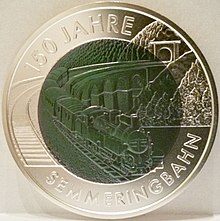
|
| March 9, 2005 |
50 years of television
The reverse side, designed by Helmut Andexlinger, shows the test image on the niobium pill that was sent in the early years of television in Austria before the broadcast began and after the broadcast, in order to be able to adjust the sharpness and calibrate the television image. The words “Republic of Austria 25 Euro” can be read on the silver ring. On the reverse side designed by Helmut Andexlinger, the niobium core represents a globe in front of which there is an analog television antenna . On the silver outer ring is a television set from the 1950s and a television camera from the 1970s. The representation of a modern editing room is bordered by three satellite dishes, which symbolize the digitization of television . You can read the words "50 years of television". From this coin with a purple core, 65,000 coins were minted in hand-lifted quality in 2005. |

|

|
| March 1, 2006 |
European satellite navigation
The obverse was designed by Herbert Waehner, pointing to the niobium pill a compass rose . This is overwritten with the coordinates of Münze Österreich AG in Vienna Am Heumarkt and the year of issue. The silver ring bears the words "Republic of Austria 25 Euro". The reverse side, designed by Thomas Pesendorfer, is designed in the niobium part as a globe on which the trajectories of satellites are drawn. In addition to the words "European satellite navigation", the silver ring shows an airplane, a container ship, a truck, an emergency vehicle and the locomotive of a high-speed train. The reason for this coin is the European satellite navigation system Galileo . From this coin with a golden brown core, 65,000 coins of hand-lifted quality were minted in 2006. |

|

|
| February 28, 2007 |
Austrian aviation
The obverse was designed by Herbert Wähner and shows the inside of a cockpit of a modern passenger aircraft. The silver ring bears the words “Republic of Austria”, “2007” and “25 Euro”. The reverse side designed by Thomas Pesendorfer shows Igo Etrich as a side view sitting in the Etrich Taube . Above it, the Etrich pigeon is shown in an overall view and in between there is a view of the Zanonia III motor glider, which was used for test flights in 1907. The silver outer ring bears the words " Luftfahrt in Österreich " and an autograph from Igo Etrich. The edition was 65,000 pieces in hand-lifted quality. |

|

|
| March 12, 2008 |
Fascination with light
A lantern lighter while working on a gas lantern , as was common in Vienna after 1800, was chosen as the motif for the obverse side . The background is the new Vienna City Hall , which is always brightly lit. The silver ring bears the inscriptions "Republic of Austria" and "25 Euro 2008". The reverse side shows a cropped portrait of Carl Auer von Welsbach on the left . The center of the niobium pill forms a stylized sun, the artificial light from various sources ( gas mantle , bulbs , power-saving lamp , fluorescent light , halogen light, LED chip and light-emitting diode ) is surrounded. In 2008, 65,000 hand-lifted coins were minted from this coin with a bright green core. The last of the 65,000 coins was minted by Brigitte Ederer , CEO of Siemens AG Austria . Their choice was intended to underline the combination of modern high technology and the fascination of light. It is not known whether Brigitte Ederer's earlier political function as the Vienna City Councilor for Finance and thus the connection to money was also kept in mind. |

|

|
| March 11, 2009 |
Year of astronomy
On the obverse side, the yellow niobium pill corresponds to the surface of the moon, while the earth, which is partially covered by the moon, is visible in the silver ring. The optical connection between the two differently colored metals is represented by a space probe . Bounded between the cut globe and the sun, the silver part of the coin bears the words “republik Österreich” and between the sun and space probe the value “25 euro”. On the niobium moon, in the form of a ¾ circle, there is the lettering “back of the moon”. On the left of the reverse side there is a section of a portrait of Galileo Galilei . In the niobium part there is a moon drawing by the astronomer with the words "year of astronomy". On the silver ring are the two years "2009" and "1609" as well as representations of various telescopes , starting with Galileo Galilei up to a space telescope. On the right edge of the coin is a representation of the observatory of Kremsmünster Abbey in Upper Austria . Both sides of the coin were designed by Herbert Wähner. 65,000 hand-lifted pieces of this coin were minted. |

|

|
| March 10, 2010 |
Renewable energy
The front of the coin shows a tree as a symbol for the cycle of nature and its energy sources. A spiral that winds away from the tree , which is firmly rooted in the earth and represents a functioning ecosystem , represents the four elements air, water, fire and earth. The sun's rays bring warmth, the leaves falling from the tree provide nutrients together with the water . The upper half of the silver coin ring bears the words “Republic of Austria 25 Euro”, while the main motif is the blue niobium core and the lower half of the silver ring. The reverse of the coin shows a stylized globe with a Pelton turbine in front of it . The extraction of geothermal energy is indicated with arrows and the cut rotor of a wind turbine stands for wind power. The solar energy is by solar rays and solar cells shown. The lower half of the silver ring bears the words "Renewable Energy". Both sides of the coin were designed by Helmut Andexlinger. The edition was 65,000 pieces in hand-lifted quality. |

|

|
| March 16, 2011 |
robotics
The value side is modeled on Leonardo da Vinci's Vitruvian man . Its place, however, is taken by a robot , which symbolizes the ideal of body proportions in the red niobium core. His arms and legs border the transition to the silver ring. In the lower half of the coin, a binary code for digitally coding information is shown on the left and three gears are shown on the right. Together, these illustrations symbolize the interaction between electronics and mechanics , which is crucial for the operation of a robot. On the back you can see a Martian landscape. A Mars robot - equipped with six wheels, collectors for generating solar power, a camera and a drilling system - is currently drilling a deep hole. The silver ring is designed as a starry sky, on the right edge you can see the globe. Also on the right, the niobium core and silver ring are superimposed by a coordination system. The value side was designed by Helmut Andexlinger, the reverse side by Thomas Pesendorfer. The circulation is 65,000 pieces exclusively in the special quality hand lifted. |

|
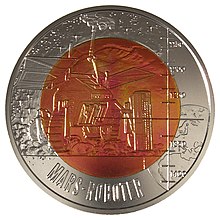
|
| February 22, 2012 |
Bionics
The obverse of the coin shows a cross-section of a nautilus snail and an eagle with outspread wings. A shark, a lotus flower and an airplane are depicted in the silver border. The year 2012 is marked with the value “25 Euro” in the niobium core, in the silver edge there is “Republic of Austria”. The reverse of the coin shows an image of the Radiolaria and details of applications of bionics in architecture. The upper half of the silver ring bears the word "Bionik". The coin was designed by Thomas Pesendorfer and Herbert Wähner. The edition was 65,000 pieces in hand-lifted quality. |

|

|
| January 23, 2013 |
Tunneling
The obverse of the coin shows a tunnel boring machine . The reverse of the coin shows a portal of a two-tube tunnel. The lower half of the silver ring bears the words "Tunnelbau". The first tunnels were built using structures used in mining, and it was more than 100 years before Ladislaus von Rabcewicz presented a pioneering new method in 1962. Under the name “New Austrian Tunneling Method”, it set a milestone in the development of modern tunnel construction and is known worldwide today and implemented in numerous international construction projects. The coin was designed by Herbert Wähner. The edition was 65,000 pieces in hand-lifted quality. |

|

|
| January 22, 2014 |
Evolution / Revolution in two colors For the first time with a two-tone niobium core in dark green and dark blue.
The obverse of the coin shows various elements from evolution and medicine, including a strand of DNA, microscope, and others. The reverse of the coin shows the transition from apes to humans in three elements. In the margin are further evolutionary steps from DNA strand to frog and bird. The coin was designed by Helmut Andexlinger. The edition was 65,000 pieces in hand-lifted quality. |
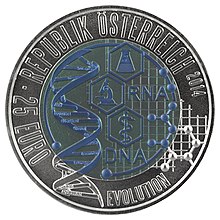
|
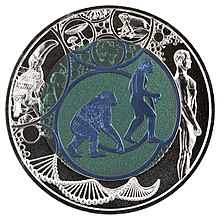
|
| January 21, 2015 |
cosmology
The obverse of the coin shows a view into space with stars, Saturn, other planets, but also the Rosetta space probe, which is orbiting a comet for the first time. The reverse of the coin shows the model of the European Extremely Large Telescope and the orbit of planets. The coin was designed by Helmut Andexlinger. The edition was 65,000 pieces in hand-lifted quality. |
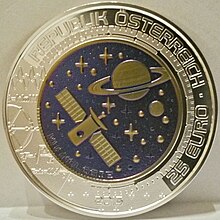
|
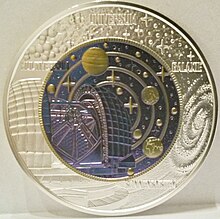
|
| March 9, 2016 |
The time
The obverse shows the sheet of a clock with Roman numerals in niobium. The twelve zodiac signs are placed further inside. In the lower right quarter of the silver ring you can see gears. One minute is visualized on the outer edge. Gears in the niobium dominate on the back. A sun was inserted into one on the left edge of the pill; on the right an hourglass. A time spiral runs from the top of the pill into the silver-colored ring. The moon is depicted on the left edge of the coin. The right half of the coin is dedicated to the time zones. For Vienna, the time was taken from the obverse. The corresponding time difference was calculated for Tokyo and New York. The coin was designed by Helmut Andexlinger. The edition was 65,000 pieces in hand-lifted quality. |

|

|
| June 7, 2017 |
The microcosm
The value side shows a butterfly with outspread wings in raspberry-red and grass-green niobium. There is an atom symbol above it . On the left you can see parts of a molecular chain that extend from the silver ring into the niobium part. The motifs in the silver ring show enlarged details of the main motif. Starting on the right: the section of a butterfly's wing, then clockwise: the enlargement of the same under a microscope and that under an electron microscope , further cell structures, finally a cell with a nucleus. On the back, a fragment of a cell is stretched over the pill, inside, starting at the top: a section of a radiant animal , then a tetrahedral molecule in a clockwise direction, a full view of a radiant animal and a bee. Placed inside a hexagon , the structure of a virus with a membrane envelope can be seen in the silver ring on the right. In a clockwise direction, polioviruses follow, then helical spirils and cocci , then a radiation animal and a cell division process. Molecules are indicated next to the three hexagons. The coin was designed by Helmut Andexlinger and Herbert Wähner . The edition was 65,000 pieces in hand-lifted quality. |

|

|
| June 6, 2018 |
Anthropocene
The silver ring on the value side shows living beings from different geological ages: an ammonite fossil ( Triassic ), a member of the Tarsophlebiidae family ( Jura ), a Triceratops ( chalk ), a saber-toothed cat ( Tertiary ), a mammoth and a human ( Quaternary ) and that Word anthropocene . In the niobium inner part you can see footprints on the globe (Europe and parts of Asia and Africa), they symbolize the traces we humans have already left on our planet. On the back of the niobium inner part, the focus is on the person. This is flanked by two deciduous trees. In the background the globe (America). Are in the ring, beginning with the right, then clockwise to see: a factory (represents the industry), plant rows (monocultures), nuclear power plants and electricity pylon (energy), the logo Pet01 (plastic polyethylene terephthalate and recycling code ). The coin was designed by Helmut Andexlinger and Herbert Wähner . The edition was 65,000 pieces in hand-lifted quality. |
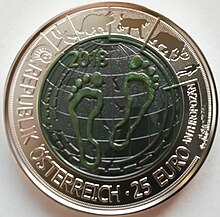
|

|
| June 12, 2019 |
Artificial intelligence
The value side of the coin shows the head of a humanoid robot and a processor on the inside made of niobium , from which conductor tracks extend into the silver ring. On the back, developments related to artificial intelligence are symbolically represented in the ring. You can see symbols for e-health, smart machines, processor development, digitization, data analysis and artificial neural networks . Neural synapses extend from the silver ring into the niobium part, where they meet a binary code . In the right inner part the silhouette of a head can be seen. The coin was designed by Helmut Andexlinger and Herbert Wähner . The edition was 65,000 pieces in hand-lifted quality. |
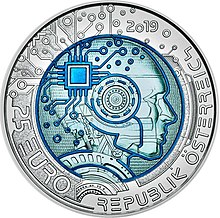
|
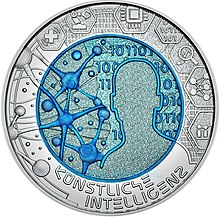
|
See also
Web links
- Planseewerke and "Austrian Aviation"
- "European satellite navigation"
- "European satellite navigation"
- "50 years of television"
Individual evidence
- ↑ a b The first 25 Euro silver niobium coin from Mint Austria. In: Mint Austria AG - Mint of the Republic of Austria. Retrieved January 10, 2016 .
- ↑ Exceptional collector's coin: 25 Euro silver niobium coin 2004. In: Münze Österreich AG - Mint of the Republic of Austria. Retrieved January 10, 2016 .
- ↑ Part 3 of the coveted silver-niobium coin series: Silver-niobium coin 50 years of television. In: Mint Austria AG - Mint of the Republic of Austria. Retrieved January 10, 2016 .
- ↑ A turquoise-blue gem: The 25 Euro silver-niobium coin 2007. In: Münze Österreich AG - Mint of the Republic of Austria. Retrieved January 10, 2016 .
- ↑ Luminous green 25 euro silver niobium coin: Fascination with light. In: Mint Austria AG - Mint of the Republic of Austria. Retrieved January 10, 2016 .
- ↑ 25 euro silver niobium coin for the year of astronomy. In: Mint Austria AG - Mint of the Republic of Austria. Retrieved January 10, 2016 .
- ↑ Bright blue: 25 Euro silver niobium coin - Renewable energy. In: Mint Austria AG - Mint of the Republic of Austria. Retrieved January 10, 2016 .
- ↑ Miracle of robotics: The 25 Euro silver niobium coin 2011. In: Münze Österreich AG - Mint of the Republic of Austria. Retrieved January 10, 2016 .
- ↑ Bionics - The tenth silver niobium coin shines in bright pink. In: Mint Austria AG - Mint of the Republic of Austria. Retrieved January 10, 2016 .
- ↑ 25 Euro silver niobium coin 2013 - Tunnel construction. In: Mint Austria AG - Mint of the Republic of Austria. Retrieved January 10, 2016 .
- ↑ Collector coins (R) Evolution: new silver-niobium coins from Mint Austria. In: Mint Austria AG - Mint of the Republic of Austria. Retrieved January 10, 2016 .
- ↑ Cosmology: Niobium coin 2015 from Austrian Mint. In: Mint Austria AG - Mint of the Republic of Austria. Retrieved January 10, 2016 .
- ↑ Die Zeit: Niobium Mint 2016 from Austrian Mint. In: Mint Austria AG - Mint of the Republic of Austria. Retrieved June 24, 2017 .
- ↑ The Microcosm: Niobium Mint 2017 from Austrian Mint. In: Mint Austria AG - Mint of the Republic of Austria. Retrieved June 24, 2017 .
- ↑ Anthropocene: Niobium Mint 2018 from Austrian Mint. In: Mint Austria AG - Mint of the Republic of Austria. Retrieved July 9, 2018 .
- ↑ Artificial intelligence: Niobium coin 2019 from Austrian Mint. In: Mint Austria AG - Mint of the Republic of Austria. Retrieved January 14, 2020 .